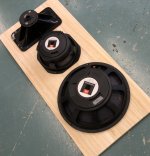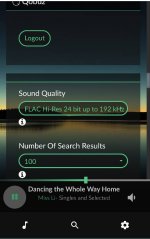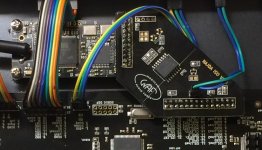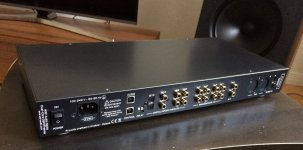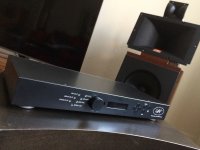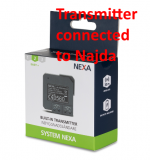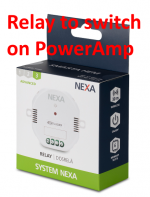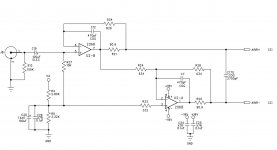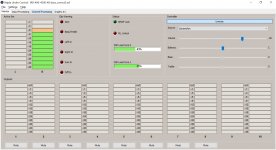Hi I’m planing to move my jRiver to RPi 4 and had thought to use the USB input on Najda. I have the boxed version that Nick built with an internal USB card into I2S.
Is the Allo Kali into I2S a better solution. I would provobly have to take out the USB card as two I2S will prowobly not work.
Can you describe the installation some more. This might also interest others as jRiver can convolve digital filter and as such add to the computing capacity of Najda.
I certainly found the Qobuz / RPi / Kali I2S in better than Jriver / Laptop / USB / WaveIO / I2S in, route.Hi I’m planing to move my jRiver to RPi 4 and had thought to use the USB input on Najda. I have the boxed version that Nick built with an internal USB card into I2S.
Is the Allo Kali into I2S a better solution. I wold provobly have to disasamble the USB card.
Can you describe the installation some more. This might also interest others as jRiver can convolve digital filter and as such ad to the computing capacity of Najda.
Probably down to the Laptop being out of the equation. I was playing FLAC and some high Res stuff.
You can read about my exploits with Kali here
https://www.diyaudio.com/forums/showthread.php?p=5918690
I certainly found the Qobuz / RPi / Kali I2S in better route.
It would be of great help to get some more specific information on which pins did you connect: RPi -> Kali -> Najda
Also, you refer to Volumio and Qobus so is there some settings to consider. In your other thread, you mention Volumio Dac setting -> "R-Pi DAC".
Have you tried to use jRiver with your setup?
Attachments
Hi Spalmgre,
I think Speedysteve7 will answer, too - but as a quick one:
Jlop has posted the connection scheme in post #3215. This one works fine in my installation (still) without Kali, but I think Speedysteve7 wrote, that the same pins are to be used with Kali mounted on top.
I am rather curious if Kali is really necessary, since I think that Najda reclocks the signal onboard. But for sure there should be no disadvantage using Kali.
Any info about sq better or not with Kali welcome!
I think Speedysteve7 will answer, too - but as a quick one:
Jlop has posted the connection scheme in post #3215. This one works fine in my installation (still) without Kali, but I think Speedysteve7 wrote, that the same pins are to be used with Kali mounted on top.
I am rather curious if Kali is really necessary, since I think that Najda reclocks the signal onboard. But for sure there should be no disadvantage using Kali.
Any info about sq better or not with Kali welcome!
I couldn't face the dismantle and reconnect procedure to try just RPi on its own, so I can't answer is RPi / Kali is better than just RPi.
Here is the diagram I used.
It's on this thread way back as above - Jlop, I thank him muchly.
The fun part is making sure the connecting wires are no longer than 4cm (=magic SQ number).
SQ with Kali is exquisite, I can confirm that.
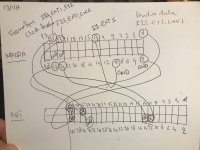
The Volumio settings I mentioned.
View attachment 851065
There's also a setting to make sure you get highest res.
I can't recall that one, it was counter intuitive.
I'll screen shot it next time I have RPi / Volumio up.
Here is the diagram I used.
It's on this thread way back as above - Jlop, I thank him muchly.
The fun part is making sure the connecting wires are no longer than 4cm (=magic SQ number).
SQ with Kali is exquisite, I can confirm that.

The Volumio settings I mentioned.
View attachment 851065
There's also a setting to make sure you get highest res.
I can't recall that one, it was counter intuitive.
I'll screen shot it next time I have RPi / Volumio up.
Last edited:
I am rather curious if Kali is really necessary since I think that Najda reclocks the signal onboard.
"Najda Startup Guid v1.3" say on page 5:
"The source connected to this port (I2S) acts as the master. All pins described in the connecting procedure above are inputs to Najda. You don't need to worry about sampling frequency as data goes through
the sample rate converter."
I shall first try without Kali but it would be nice to find if somebody already has tried and know what was the outcome. Costs add up so if Kali is not needed then I like to save my money.
I attached some pictures for thous of you who have not seen the WAF boxed Najda. It is of highest quality and really feels solid and well done. There is room in the box so an RPi should fit nicely. But what do you say about the board between the USB card and the main Najda board?
Attachments
I couldn't face the dismantle and reconnect procedure to try just RPi
If the RPi is in the box how do you start and shut down without getting problems with the software?
If I mount the RPi inside the box then I like to start as I always do with the remote control. I have installed a relay to be able to send ( see pictures) a wireless start signal to my power amplifiers.
This is fine with the Nexa transmitter as it is meant to work as a remote wireless light or whatever switch that has two positions on and off.
Najda provides the relay closed (1) position when on. And opens the relay (0) when off.
The start/shutdown buttons that come with some RPi boards seem to want you to hit the button once for on and once more for shut down.
--------------
If somebody wants to use the Nexa transmitter then you have to install a relay that Najda operates. This relay then holds the transmitter in on position.
Attachments
Last edited:
If the RPi is in the box how do you start and shut down without getting problems with the software?
If I mount the RPi inside the box then I like to start as I always do with the remote control. I have installed a relay to be able to send ( see pictures) a wireless start signal to my power amplifiers.
This is fine with the Nexa transmitter as it is meant to work as a remote wireless light or whatever switch that has two positions on and off.
Najda provides the relay closed (1) position when on. And opens the relay (0) when off.
The start/shutdown buttons that come with some RPi boards seem to want you to hit the button once for on and once more for shut down.
--------------
If somebody wants to use the Nexa transmitter then you have to install a relay that Najda operates. This relay then holds the transmitter in on position.
I always put my Najda into standby and then switch OFF at the mains power.
Both my Najda PSUs are ON when the mains is ON, Najda is woken up by its power button.
The RPi's and Kali's PSU's also ON with the mains ON.
The RPi boots up, runs it's code and starts Volumio, and is available to xxx.xxx.x.x address on my browser device through my WiFi network.
When I'm done I put Najda into standby & use Volumio Settings / Shutdown / Poweroff to put Volumio / RPi to sleep, before I switch OFF the mains.
All takes but a few seconds to power up or shutdown.
If you just turn RPi off without shutting down and it's read/writing to the SD card the card can become corrupted.
I've got a light on the side of my Najda box that shows the SD accessing. Once it's solid red, power OFF is safe.
All my mains / traffos are external to Najda. There is just 3 X 5v linear supply for RPi, Kali and Najda, and the 12-0-12 AC supply (shielded and isolated), coming inside the Najda case.
The board that converts the latter to 12-0-12 DC for Najda is adjacent.
Last edited:
A stupid question, maybe.... I have just started playing with FIR’s with my Nadja. After spending some time with rephrase making some simple crossovers to test was stumped for a while whilst testing the crossovers why I wasnt getting any output. I then realised I have to put a pass through equation in the input processing tab, to get an output. With my simple crossovers I am almost out of processor capability 🙁. Has anyone got any advise on what the minimum processor hungry equation I can get away with using for the input processor tab.
A stupid question, maybe.... I have just started playing with FIR’s with my Nadja. After spending some time with rephrase making some simple crossovers to test was stumped for a while whilst testing the crossovers why I wasnt getting any output. I then realised I have to put a pass through equation in the input processing tab, to get an output. With my simple crossovers I am almost out of processor capability 🙁. Has anyone got any advise on what the minimum processor hungry equation I can get away with using for the input processor tab.
just create with Rephase a file with 1 sample at the chosen frequency (48 or 96Khz in Najda), do not create a correction of course, and place the file in the entry menu of Najda.
I use 6 files with 512 samples, 96Khz + 2 files with 1 samples, for a total activity of the 2 Najda processors at around 82%. It is not possible to go beyond the 6 x 512 FIR samples at 96KHz on Najda, because too much computation for the processors.
Hi,
I guess I killed right channel of analogue input. Have version 1.3. Normally it's configured for 1Vrms. I'm using turntable on that input so this level is perfect for it as I don't have to put too much gain on preamp.
Lately I connected there PC card and one right channel died. I hear constant noise on it. In NUC right input level is constantly displayed as -3dBa.
While switching to digital input everything is fine.
So what could be wrong? Fried input on CS42428? Or there is a chance that something in input buffer died?
Anyone has schema of input buffer? Have one from CS42428 evaluation board, but probably on Najda there where some changes (ex. input level selector).
For a start I'll check opamp and path from input to ADC. CS42428 re-soldering will be painful in worst case.
I guess I killed right channel of analogue input. Have version 1.3. Normally it's configured for 1Vrms. I'm using turntable on that input so this level is perfect for it as I don't have to put too much gain on preamp.
Lately I connected there PC card and one right channel died. I hear constant noise on it. In NUC right input level is constantly displayed as -3dBa.
While switching to digital input everything is fine.
So what could be wrong? Fried input on CS42428? Or there is a chance that something in input buffer died?
Anyone has schema of input buffer? Have one from CS42428 evaluation board, but probably on Najda there where some changes (ex. input level selector).
For a start I'll check opamp and path from input to ADC. CS42428 re-soldering will be painful in worst case.
Attachments
Hello Jbator, there is a good chance that the OP amplifier just behind the right input is out of service, the ADC input of the CS42428 must not be damaged. The diagram attached to your post is the one used by Nick with some variation on the values of the link capacitors and the addition of the input attenuator.
Fortunately it was an opamp failure. But why it failed? Input max voltage for LM833 is +/-15V so definitely I did no exceeded that. Maybe some ESD or so.
I borrowed opamp form channels 1/2, tomorrow I'm going for shopping. Is there a point to use any other opamp on input part?
This is how it looked like with nothing connected to the input.
I borrowed opamp form channels 1/2, tomorrow I'm going for shopping. Is there a point to use any other opamp on input part?
This is how it looked like with nothing connected to the input.
Attachments
Last edited:
Several opamp (x2) used in the audio world can work, they just have to have the same pinout, then it's a question of musical "color", already make a choice by checking the datasheet, and listen, by experience the most expensive are not the most musical ...
Hi folks !
I would like to put in a box my Najda 1.3 + power supply + USB/I2S converter.
Can you advice me to choose how to do the front & back plates ?
In europe we have modushop for example but I'm looking for cheaper alternatives...
++
I would like to put in a box my Najda 1.3 + power supply + USB/I2S converter.
Can you advice me to choose how to do the front & back plates ?
In europe we have modushop for example but I'm looking for cheaper alternatives...
++
I used Schaeffer AG.
The drawing software is really very well done and the result is superb.
On the other hand, in terms of price, I don't think it's cheaper.
The drawing software is really very well done and the result is superb.
On the other hand, in terms of price, I don't think it's cheaper.
Hi folks !
I would like to put in a box my Najda 1.3 + power supply + USB/I2S converter.
Can you advice me to choose how to do the front & back plates ?
In europe we have modushop for example but I'm looking for cheaper alternatives...
++
Try Quickpanel
Customized front-panels, electronics panels, face panels, device panels, front-plates, anodized panels, aluminium panels
Anybody had problems with the spdif input? My started to sound bad and had drop outs, it got worse and worse until it stopped working completely. Perhaps some static electricity killed it, or some currents from my htpc where responsible, don't know. I'm using the toslink now but would be nice (if possible) to be able to fix the spdif input. I haven't opened the box up for a inspection. Suspect there are some components that has died on me.
- Home
- Source & Line
- Digital Line Level
- DSP Xover project (part 2)
